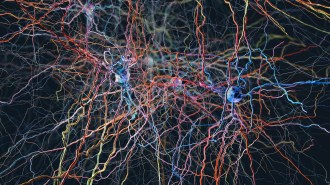For the blind, hearing the way forward can be a tradeoff
Enhanced localization abilities in one plane may come at the expense of another

People who have been blind since childhood sometimes have better hearing than sighted people, but a new study finds that enhanced hearing in one direction may come at the expense of another.
hilmi_m/iStockPhoto
- More than 2 years ago
There’s a common notion that people who have deficiencies in one sensory area must have enhancements in others: People with hearing loss have better sight, and people who are blind certainly must have better hearing. That idea even shows up in our superhero stories. Mild-mannered lawyer by day, vigilante by night, Marvel’s Daredevil cannot see. He was blinded as a child. But the same radioactive sludge that took his sight enhanced his other abilities. He now has superhuman hearing, touch, smell and even a vague sort of radar.
But real life isn’t quite like that.
“We have this idea that people without vision are necessarily better in all other senses,” says David Burr, a vision researcher at the University of Florence in Italy. “But it’s not necessarily the case.” Many blind people have better pitch perception than sighted people. They also have better sound localization for sounds on the periphery of a space, and parts of the visual cortex are recruited for auditory sound processing in people who are blind. A new study shows that some people who have been blind for most of their lives do have enhanced hearing. This hearing enhancement is a sensory tradeoff. But the tradeoff isn’t between sight and sound. Instead, it’s a tradeoff between two different hearing directions.
Study coauthor Patrice Voss, a cognitive neuroscientist at McGill University in Montreal, was especially interested in how people who have been blind since early in life might use spectral cues to find out where a sound is coming from. When a sound is in the horizontal plane (in front of us, behind or to either side) we usually pinpoint it binaurally — our brains compare the difference in sound timing between our right and left ears. But when identifying sounds in the vertical plane (above or below us, in a straight line from the top of our heads), the sound travels an equal distance to each ear, so there aren’t right-left cues to give us location. Instead, we use spectral cues: Subtle differences in how our outer ears, or pinnae, shape the sound as it comes in. We also use these spectral cues when one of our ears is blocked, taking away our ability to use the binaural method to locate the source of a sound.
To compare how blind people navigate in the horizontal and vertical plane, Voss and his colleagues played sounds for sighted people and people who have been blind since childhood. The sounds came from either the front and sides (the horizontal plane) or the above and below (the vertical plane). For each sound, blindfolded volunteers had to aim a laser pointer toward where they thought the sound was coming from. They did this with both ears open and with one ear blocked.
The scientists quickly found that the blind participants fell into two groups. One group was better at locating sounds in the horizontal plane with one ear blocked — using spectral cues — while the other group was no better than sighted people at locating the source of the sound. When the blind subjects had to pinpoint sounds in the vertical plane, the group that performed normally in the horizontal plane continued to perform normally, just as sighted people did. But the group that had enhanced abilities when locating sounds side-to-side actually had deficits when locating sounds up and down.
So the improved use of spectral cues in the horizontal plane in some blind people may be a tradeoff for abilities in the vertical plane — not simply an enhancement that comes from being blind. Voss says that this is a logical tradeoff to make. “When a blind person navigates, most of the relevant sounds are in the horizontal plane [objects or people coming at you from the front, sides or behind],” he explains. “Not much relevant information coming from above. [Blind people] could learn to attach greater importance to signals from the horizontal plane and sacrifice the ability to localize on the vertical plane.” Voss and his colleagues published their findings April 15 in the Journal of Neuroscience.
How we use spectral cues isn’t innate, it’s something that we learn, notes Andrew King, an auditory neuroscientist at the University of Oxford. “If you have a hearing loss in one ear, the auditory system immediately starts boosting the auditory reliance on spectral cues,” he explains. King says this study emphasizes how plastic our auditory systems can be, enhancing detection in one plane at the sacrifice of another.
But he also notes that the culprit for sound localization might not be the spectral cues. Instead, it might be a phenomenon called head shadow. If one of your ears is plugged, any sound played will sound softer, as only the open ear can hear it. This muted sound could have provided a cue the study’s participants relied on, without having to use the spectral cues from sounds entering the pinna. The scientists used only one volume of tone during their experiments, so to make sure that it really is the spectral cues at play, they would have to try the test with many different volumes of tone, King says.
As for a real-life Daredevil, with hugely enhanced senses? “It’s not a complete myth,” Voss says, extrapolating his new findings to the superhero. “He’s probably better at hearing certain things, but not everything.”






